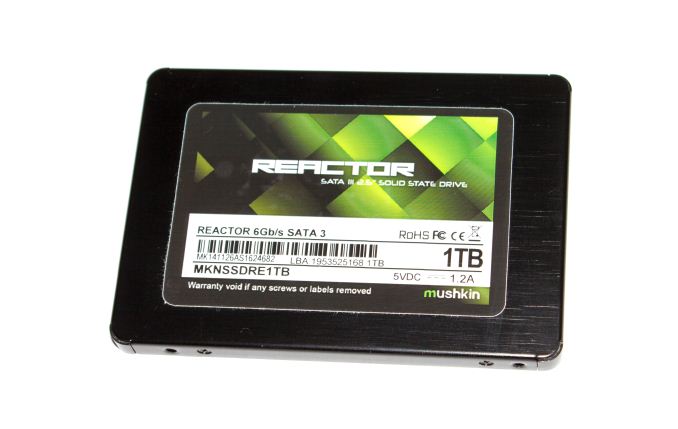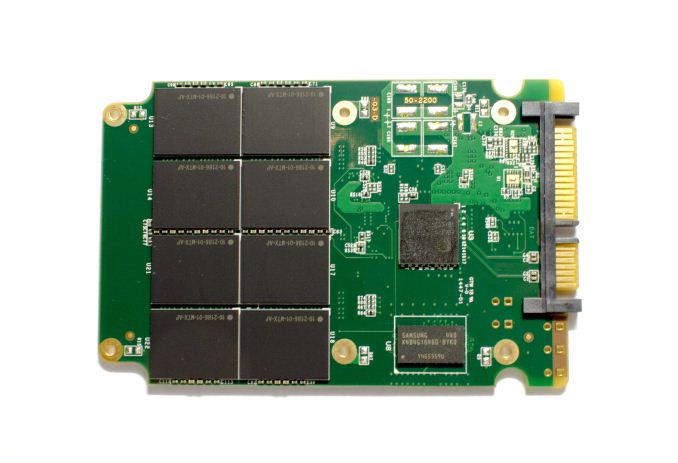Mushkin Reactor 1TB SSD Review
by Kristian Vättö on February 9, 2015 11:32 AM EST- Posted in
- Storage
- SSDs
- Mushkin
- Silicon Motion
- SM2246EN
- Reactor
- Micron 16nm

Silicon Motion has practically become the new SandForce. Almost every tier three manufacturer (i.e. one with no controller/firmware IP or NAND fab) has released an SM2246EN based drive in the past ten months and recently Silicon Motion scored two major tier one partners (namely Micron/Crucial and SanDisk) as well. To be honest, this hasn't come as a surprise because the SM2246EN is a really solid controller with good performance and more importantly it's been mostly issue free (which is something that cannot be said about SandForce).
Mushkin's Reactor combines the SM2246EN with Micron's latest 128Gbit 16nm MLC NAND, and this is actually the first time I've encountered a non-Micron/Crucial SSD with Micron's 16nm NAND. That really emphasizes the benefit NAND manufacturers have because Micron has been using 16nm NAND in its own SSDs for over six months now, but the company hasn't begun shipping it to others in volume until now. I suspect the volumes are still fairly low because the Reactor only comes in 1TB capacity, which is still fairly expensive and thus limits the demand to a level that is easier to manage compared to the more popular 256GB and 512GB models. I was told that 256GB and 512GB models may follow later, but as of now Mushkin will only be offering the Reactor in 1TB.
| Mushkin Reactor Specifications | |
| Capacity | 1TB |
| Controller | Silicon Motion SM2246EN |
| NAND | Micron 128Gbit 16nm MLC |
| Sequential Read | 560MB/s |
| Sequential Write | 460MB/s |
| 4KB Random Read | 74K IOPS |
| 4KB Random Write | 76K IOPS |
| Encryption | N/A |
| Endurance | 144TB |
| Warranty | Three years |
In terms of features the Reactor is a fairly typical value drive without any special features. Neither hardware accelerated encryption nor DevSleep is supported, although the Reactor does support slumber power states for low idle power consumption. Endurance is a respectable 144TB, which translates to 131GB of writes per day for three years.
Moreover, the retail package doesn't include anything in addition to the drive itself and Mushkin offers no software/toolbox for its SSDs.
There are sixteen NAND packages on the PCB with eight on each side. Since we are dealing with a 128Gbit (16GB) die, that translates to four dies per package. Mushkin actually does the packaging in-house (i.e. buys NAND in wafers and then does the binning and packaging), which is why the packages lack the typical Micron logo and labels.
Test Systems
For AnandTech Storage Benches, performance consistency, random and sequential performance, performance vs. transfer size, and load power consumption we use the following system:
| CPU | Intel Core i5-2500K running at 3.3GHz (Turbo & EIST enabled) |
| Motherboard | ASRock Z68 Pro3 |
| Chipset | Intel Z68 |
| Chipset Drivers | Intel 9.1.1.1015 + Intel RST 10.2 |
| Memory | G.Skill RipjawsX DDR3-1600 4 x 8GB (9-9-9-24) |
| Video Card | Palit GeForce GTX 770 JetStream 2GB GDDR5 (1150MHz core clock; 3505MHz GDDR5 effective) |
| Video Drivers | NVIDIA GeForce 332.21 WHQL |
| Desktop Resolution | 1920 x 1080 |
| OS | Windows 7 x64 |
Thanks to G.Skill for the RipjawsX 32GB DDR3 DRAM kit
For slumber power testing we used a different system:
| CPU | Intel Core i7-4770K running at 3.3GHz (Turbo & EIST enabled, C-states disabled) |
| Motherboard | ASUS Z87 Deluxe (BIOS 1707) |
| Chipset | Intel Z87 |
| Chipset Drivers | Intel 9.4.0.1026 + Intel RST 12.9 |
| Memory | Corsair Vengeance DDR3-1866 2x8GB (9-10-9-27 2T) |
| Graphics | Intel HD Graphics 4600 |
| Graphics Drivers | 15.33.8.64.3345 |
| Desktop Resolution | 1920 x 1080 |
| OS | Windows 7 x64 |
- Thanks to Intel for the Core i7-4770K CPU
- Thanks to ASUS for the Z87 Deluxe motherboard
- Thanks to Corsair for the Vengeance 16GB DDR3-1866 DRAM kit, RM750 power supply, Hydro H60 CPU cooler and Carbide 330R case











69 Comments
View All Comments
nathanddrews - Monday, February 9, 2015 - link
That didn't stop them from releasing 1TB SSDs for $800, which have conveniently come down...rahuldesai1987 - Monday, February 9, 2015 - link
Samsung 860 Evo is likely to be 2TB.Christopher1 - Sunday, February 15, 2015 - link
Who would need all that space on an SSD save an uber-gamer? I personally put an SSD in my laptop but I download and store all my stuff to an external hard drive that is a USB 3 spinny disk.Greg100 - Tuesday, February 10, 2015 - link
What??? I am still waiting for Samsung PM863 - 3.84TB capacity in 2.5" form factor! The price doesn't matter. I will buy two or three of them.Levish - Thursday, January 14, 2016 - link
Mostly it comes down to supply vs demand, imagine if for example Samsung released a Hypothetical 1TB EVO SATA 6Gbps at $50 - $100 and a pro at $125 - $150 pretty much no one else would sell a consumer / oem SSD.What kills me is the pricing difference of M.2 NVMe disks, other than the initial R&D to produce they should be way cheaper than SATA varieties
Tom Womack - Tuesday, February 10, 2015 - link
1TB is enough for most laptops, and few cases are short enough of space or SATA ports that you can't strap together two 1TB drives in RAID0, so there's very little pressure to produce 2TB drives at less than twice the price of 1TB drives; if you want 4TB of SSD tomorrow you can buy four drives and fiddle around a little with Molex-to-SATA-passthrough power adaptors.Cpt. Obvious - Tuesday, February 10, 2015 - link
There's also a big push for cloud services. Local storage is often seen as unreliable and inconvenient, especially when the user is supposed to be using several platforms to access the same data. And let's be honest, the cloud services are very convenient, when they work.The big problem with cloud storage, in my opinion at least, is bandwidth. For most people It's simply not efficient to work with large volumes of data over the internet. Even many popular games are running into several gigabytes. Recently I reinstalled a game that's a few years old, Borderlands, and the download from Steam was over 12GB. That's not something I'd like to run from a cloud storage. But even then I could fit 80 games of this size on a one TB SSD.
Movies is another subject. A 1080p movie stored in a good quality can be about 20 - 25 GB, so that 1TB drive could house about 40 of these. However movies are generally read sequentially, and they don't need a very high transfer rate so they are prime candidates for storing on cheap HDD's in a NAS and / or using cloud storage.
So where is the multi TB SSD demand in the consumer market today? I think 4K video editing is one of the few cases where consumers may need multi TB SSD's. Note that I say "need" not "want", because I for one sure "want" as large a SSD as I can get for a reasonable price. I might not fill it up, but I still want it...
When it comes to professional use things are a lot different. If you work with huge sets of data you will need both large and fast storage. But then again that is already available, though at prices thats out of range for most end users.
cm2187 - Friday, February 13, 2015 - link
Particularly upload bandwidth. In my country most optic fibre providers only have upload speeds a tenth of the download speed. Most pictures today are 2-6MB out of the camera (mobile to DSLR). A photo roll from a birthday or a trip can be pretty long to upload. And we are not even talking audio or video.Plus there is the trust issue. Do you really want to upload all your private life to the internet?
Christopher1 - Sunday, February 15, 2015 - link
Actually, a 1080p in H.265 format (the one that people are switching to) should be only 1GB, tops for a two-hour movie in 23.9-24 fps at a pretty high Kbps.Yes, movies are usually read sequentially but the problem is that many drives do not store data sequentially.
Every single time I download a TV show, I have to defrag the hard drive or the file itself to get it sequential on a spinny disk hard drive and play it's best.
Christopher1 - Sunday, February 15, 2015 - link
Local storage is one of the most reliable things in the world today, especially since a lot of cloud hosters are now doing the insanity of removing anything that is 'flagged' by their systems as 'possibly pirated'. I just would not trust them with my data.